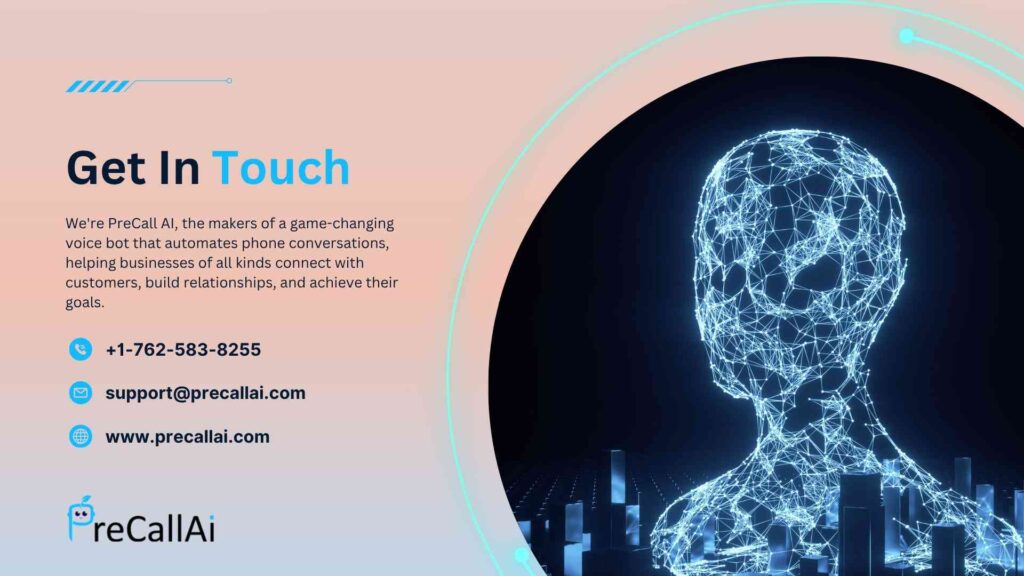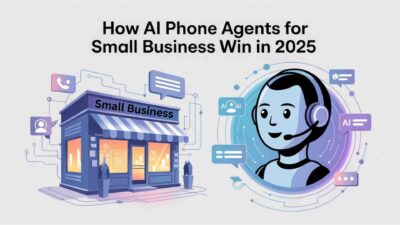Introduction
Cold calling has been a go-to method that outbound sales have used for years, helping businesses grow, close deals, and find new customers. However, frankly, nobody likes to make cold calls or get them. Salespeople dislike it, managers dislike it, and the pick-up crew dislikes it. AI in cold calling steps in there. With smart tech, platforms like PreCallAI are changing how cold calls work. This makes cold calls faster and more efficient, and less painful for everyone using Natural Language Processing with voice automation. However, does a live operator offer better service than AI?
Table of Contents
In this blog, we will explore what is AI for cold calling, and what are the human struggles for traditional calls, why companies are turning to AI for cold calling AI in comparison to human cold callers, and then we will share just how companies are now using the PreCallAI tools, as we examine all of their pros and cons, and help you to decide when you should use AI rather than a human touch.
What Is AI for Cold Calling
AI for cold calling refers to the use of AI-powered voice assistants able to initiate, manage, and respond to cold sales calls without a human involved in real time. Voice bots can seem natural, information can be collected, appointments can be scheduled, and objections can be handled.
It is just like having a script-perfect and tireless sales representative who does not mind rejection, does not burn out, and never sleeps.
Platforms such as PreCallAI do understand customer intent via advanced NLP as well as contextual awareness. These platforms reply in a human-like tone and guide conversations towards conversion in real time.
Human Struggles With Traditional Calls
1. Rejection Is Constant:
Most cold calls do not end with a sale or even a polite “no.” they end with hang ups, voicemails, or irritated responses like “Take me off your list.” for reps making 80-100 calls a day, that’s a whole lot of rejection. It gradually reduces motivation, confidence, and job happiness.
2. Repetitiveness Kills Enthusiasm:
Cold calling is often highly repetitive. Repeat the same script, define the same product, and deal with the same concerns again and over. This repetition causes mental tiredness, disinterest, and finally, burnout. Even the most enthusiastic reps can lose their spark after the 50th “not interested” of the day.
3. Timing Is Never Perfect:
You have no control over when someone picks up. Maybe they are attending a conference, caught in traffic, or simply not in the mood. Human callers face unpredictable situations every time the phone rings. And when they do get through, there is pressure to make the perfect pitch in just seconds before the prospect mentally checks out.
4. Distractions and Multitasking:
Salespeople don’t only cold call; they also answer emails, enter data into CRMs, attend meetings, and pursue leads. Multitasking reduces focus, slows down productivity, and increases the chance of errors. Not to mention, after a few bad calls, it’s tempting to scroll LinkedIn for a “quick break.”
5. Burnout and Turnover:
Cold calling takes a toll. The constant rejection, pressure to hit targets, and lack of variety make burnout common. That’s why sales roles, especially outbound ones, often have high turnover rates. Companies end up spending time and money hiring and training new reps, only for the cycle to repeat.
6. Limited Working Hours:
Even the most committed rep can’t call prospects 24/7. Calls are usually limited to business hours, and reps need breaks, weekends, vacations, and sick day. This means leads outside time zones or after-hours interest often go unanswered, or worse, straight to voicemail and are never followed up.
7. Inconsistent Performance:
Humans are not machines. A representative might crush it one day, and barely convert the next. Energy levels, mood, and distractions all impact how well a call goes. Some reps skip steps. Others forget to take notes. These inconsistencies can hurt both conversion rates and customer experience.
Why Companies Are Turning To AI For Cold Calling
1. Scalability Without Burnout:
Human agents have limits. Even top-performing sales reps can only handle around 80–100 calls per day, and that’s on a good day. Now imagine trying to scale that to thousands of leads without hiring and training a small army of callers. AI, on the other hand, can make hundreds or even thousands of calls per day, all without breaks, lunch hours, or mental fatigue.
There’s no burnout, no “bad days,” and no “I’ll call them tomorrow.” It’s always on, always active, and always ready to reach the next lead. That kind of scalability makes AI the perfect fit for high-volume campaigns or reactivating old databases.
2. Consistent Messaging:
As well, sales reps are not robots. Some might follow the script to a tee, others might get with their pitch, not always in a good way. And when team members vary in experience, tone, or enthusiasm, so does your brand’s messaging.
AI solves this by delivering crystal-clear, consistent messaging every time. With structured, pre-tested scripts and logic-based flows, AI ensures that each call stays on track and aligned with your campaign goals. No awkward improv
AI solves this by delivering crystal-clear, consistent messaging every time. With structured, pre-tested scripts and logic-based flows, AI ensures that each call stays on track and aligned with your campaign goals. No awkward variations, no missed talking points, just steady, reliable conversations that reflect your brand perfectly.
3. Real-Time Learning and Adaptation:
Today’s AI voice assistants, like those powered by PreCallAI, don’t just talk. They listen, learn, and adapt. Using Natural Language Processing (NLP) and machine learning, these systems analyze real-time conversations, detect sentiment in the caller’s voice, and respond in a contextually appropriate way.
For example, if a prospect sounds hesitant, the AI can switch to a softer tone or offer additional information. Over time, the system becomes smarter, identifying which phrases or responses work best and refining the experience for future calls, just like a top-performing sales rep with years of experience under their belt.
4. Cost-Effective in the Long Run:
Hiring, training, and managing a team of cold callers is expensive. You have to factor in salaries, commissions, training programs, benefits, and turnover costs. Now add the time lost due to errors, inconsistency, or burnout.
With AI, you make an upfront investment to set up the system, but once it’s live, the ongoing costs are minimal. You don’t have to pay for sick leave, incentives, or management oversight. For businesses looking to scale efficiently, AI cold calling offers a massive return on investment.
5. 24/7 Availability:
AI does not sleep, take weekends off, or disappear during holidays. It is available 24/7/365, making it possible to reach leads across different time zones or follow up with prospects during non-working hours when they might be free to take a call.
This always-on capability ensures no lead goes cold simply because it was missed during regular business hours. Whether it is a night owl in New York or an early bird in London, AI can make the call, anytime, anywhere.
Common Misconceptions About AI For Cold Calling
Let’s expose some myths:
Myth 1: AI sounds like a robot
Not anymore. Today’s AI can mimic human tone, timing, and conversation flow so well, most people won’t notice.
Myth 2: AI can’t handle complex conversations
AI indeed has limits, but for initial outreach, qualification, and scheduling, it is more than capable. For complex discussions, AI can pass leads to human agents smoothly.
Myth 3: Customers hate talking to bots
They hate bad bots. A well-designed AI that respects their time and offers quick value? That’s a win.
Why Is AI For Cold Calling on the Rise?
AI-powered cold calling is rapidly transforming the sales industry, making outreach more efficient, scalable, and data-driven. Traditional cold calling has often been associated with low conversion rates and high rejection rates, but AI is revolutionizing the process by automating tasks, improving lead targeting, and enhancing personalization. Here is why AI cold calling is on the rise:
1. Advancements in AI Technology:
AI-driven tools now leverage Natural Language Processing (NLP), Machine Learning (ML), and Voice Recognition to improve call quality. These technologies enable AI to analyze customer sentiment, prioritize leads, and even engage in basic conversations before transferring calls to human agents. As AI continues to evolve, its ability to mimic human-like interactions is becoming more refined, making cold calls feel more natural and engaging.
2. Cost Efficiency & Scalability:
Businesses are constantly looking for ways to optimize operations and reduce costs. AI cold calling allows companies to reach more prospects in less time, eliminating the need for large sales teams. Automated systems can handle thousands of calls simultaneously, ensuring that businesses maximize their outreach efforts without significantly increasing expenses.
3. Decline of Cold Email Effectiveness:
With AI-driven spam filters becoming more sophisticated, cold emails are losing their effectiveness. Many businesses are shifting back to phone-based outreach as AI-powered cold calling offers a more direct and engaging approach. Additionally, the rise of Large Language Models (LLMs) has led to an inflow of templated emails, reducing response rates and making personalized phone interactions more valuable.
4. Improved Lead Targeting & Personalization:
AI can analyze vast amounts of customer data to identify high-quality leads. By leveraging predictive analytics, AI cold calling systems can prioritize prospects based on their likelihood to convert. Also, AI-powered systems personalize conversations by behavior, preferences, and past interactions, making calls more relevant and engaging.
5. Automation of Repetitive Tasks:
AI cold calling automates various repetitive tasks, such as dialing, voicemail drops, and follow-ups. This allows human agents to focus on closing deals rather than spending time on administrative work. AI-driven predictive dialers ensure that sales reps only engage with promising leads, increasing efficiency and improving overall sales performance.
6. Real-Time Analysis & Insights:
AI monitors conversations in real time, providing valuable insights to sales teams. By analyzing tone, sentiment, and engagement levels, AI can suggest adjustments to improve sales strategies. This data-driven approach helps businesses refine their outreach methods and enhance customer interactions.
“Also Read: Success story showing how a real estate firm increased lead conversions using AI calling”
Conclusion

If your goal is to reach more prospects in less time, cut costs without cutting quality, and free up your sales team to focus on closing deals, then yes, AI for cold calling is better than human agents, especially for the first touch.
That does not mean humans are out of the picture. It means they are playing a smarter role in a more efficient system. In 2025 and beyond, the most successful sales teams won’t choose between AI and humans; they will combine them.





